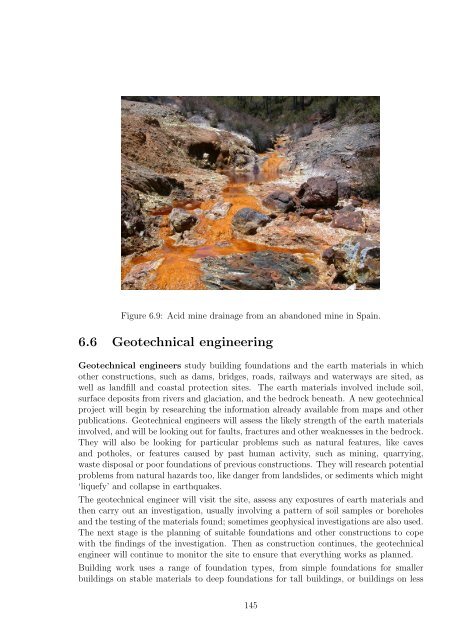The planet we live on: The beginnings of the Earth Sciences
The planet we live on: The beginnings of the Earth Sciences
The planet we live on: The beginnings of the Earth Sciences
- No tags were found...
You also want an ePaper? Increase the reach of your titles
YUMPU automatically turns print PDFs into web optimized ePapers that Google loves.
Figure 6.9: Acid mine drainage from an aband<strong>on</strong>ed mine in Spain.6.6 Geotechnical engineeringGeotechnical engineers study building foundati<strong>on</strong>s and <strong>the</strong> earth materials in whicho<strong>the</strong>r c<strong>on</strong>structi<strong>on</strong>s, such as dams, bridges, roads, railways and waterways are sited, as<str<strong>on</strong>g>we</str<strong>on</strong>g>ll as landfill and coastal protecti<strong>on</strong> sites. <str<strong>on</strong>g>The</str<strong>on</strong>g> earth materials involved include soil,surface deposits from rivers and glaciati<strong>on</strong>, and <strong>the</strong> bedrock beneath. A new geotechnicalproject will begin by researching <strong>the</strong> informati<strong>on</strong> already available from maps and o<strong>the</strong>rpublicati<strong>on</strong>s. Geotechnical engineers will assess <strong>the</strong> likely strength <strong>of</strong> <strong>the</strong> earth materialsinvolved, and will be looking out for faults, fractures and o<strong>the</strong>r <str<strong>on</strong>g>we</str<strong>on</strong>g>aknesses in <strong>the</strong> bedrock.<str<strong>on</strong>g>The</str<strong>on</strong>g>y will also be looking for particular problems such as natural features, like cavesand potholes, or features caused by past human activity, such as mining, quarrying,waste disposal or poor foundati<strong>on</strong>s <strong>of</strong> previous c<strong>on</strong>structi<strong>on</strong>s. <str<strong>on</strong>g>The</str<strong>on</strong>g>y will research potentialproblems from natural hazards too, like danger from landslides, or sediments which might‘liquefy’ and collapse in earthquakes.<str<strong>on</strong>g>The</str<strong>on</strong>g> geotechnical engineer will visit <strong>the</strong> site, assess any exposures <strong>of</strong> earth materials and<strong>the</strong>n carry out an investigati<strong>on</strong>, usually involving a pattern <strong>of</strong> soil samples or boreholesand <strong>the</strong> testing <strong>of</strong> <strong>the</strong> materials found; sometimes geophysical investigati<strong>on</strong>s are also used.<str<strong>on</strong>g>The</str<strong>on</strong>g> next stage is <strong>the</strong> planning <strong>of</strong> suitable foundati<strong>on</strong>s and o<strong>the</strong>r c<strong>on</strong>structi<strong>on</strong>s to copewith <strong>the</strong> findings <strong>of</strong> <strong>the</strong> investigati<strong>on</strong>. <str<strong>on</strong>g>The</str<strong>on</strong>g>n as c<strong>on</strong>structi<strong>on</strong> c<strong>on</strong>tinues, <strong>the</strong> geotechnicalengineer will c<strong>on</strong>tinue to m<strong>on</strong>itor <strong>the</strong> site to ensure that everything works as planned.Building work uses a range <strong>of</strong> foundati<strong>on</strong> types, from simple foundati<strong>on</strong>s for smallerbuildings <strong>on</strong> stable materials to deep foundati<strong>on</strong>s for tall buildings, or buildings <strong>on</strong> less145
















